EVENINGS ALONG THE STREAM (part 16)
| Sysadmin Note |
|---|
| Part fifteen can be found here |
July 8th, today the Yellowstone River dropped below 30,000 CFS [2011] and this set a record for the number of day that the river was above that mark. Also today the Salmon Flies began to hatch on the Yellowstone and they are three weeks behind their normal hatching date. At the rate of the drop I still don't expect the river to be fishable before August 10th. In a normal year the river would be fishable between June 25th and July 4th with the flows below 9,000 CFS. It has a ways to go before it will be fishable.
Today we spent the day on the house pond fishing midge imitations; therefore I thought that I would pass on the information on midge fishing that I shared with my clients. However I decided that I would get the help of one of my trout friends to help me write down this information. I figured that this format would add a touch of humor.
THE TROUT, THE BUGS & THE ANGLER/TYER
Midges are found in rivers, stillwaters and spring creek water types all over the country. These insects are of vital importance to both the trout and the angler/tyer. In this column I shall endeavor to pass along some of the intimate knowledge about midges that I have acquired. You might say that this information is straight from the trout's mouth! My friend the Yellowstone Fly Tyer will also be explaining the technical side of the fly tying. He might also comment on various presentation methods. However we will try to limit his rambling. Anyhow, who understands presentation methods better than "Bugzy"? Oh the stories I could tell you. I have seen it all!
To clear up any confusion and to set the record straight we need to have a statement of definitions. When speaking of midges I am referring to an insect that closely resembles the pesky mosquito but they don't bite. Often angling literature is confusing since the term midge is used to describe small mayflies. Our friends in Great Britain often refer to trout feeding on midges as "smutting rises". In truth, midges are a species by themselves and should not be confused with other insects.
As a matter of fact, the midge and mosquito are cousins, so to speak. Midges belong to the order of Diptera. Diptera is formed from the words "Di" meaning two and "ptera" meaning wings. Diptera are highly specialized, two winged flies including many common insects such as the housefly, mosquito, crane fly, horse fly, and black fly. The family group of Diptera we are interested in is the Chironomidae (midges). There are well over 100 genera with over 2,000 species in North America. I see no useful reason for the angler/tyer to try to identify individual species of midges, but to each his own. Myself, I'm more interested in eating them than in identifying them!
Midges, like the caddisfly, go through a complete metamorphosis consisting of egg, larva (worm), pupa and adult. All stages of the midge are available to the trout. Some midges require as long as a year to mature, but in many cases only a few weeks is needed. Some species hatch out several generations per year in spring creek water and stillwater environments.
The larvae are worm-like and dwell on the bottom, clinging to rocks or other bottom obstructions as well as inhabiting weed beds. As they are always moving around in search of food they are very available to us trout and we feed on them on a regular basis.
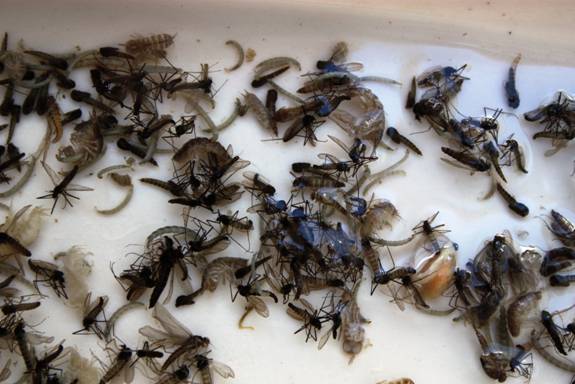
To demonstrate just how important midges are, listen to this little fact from the Yellowstone Fly Tyer. Based on stomach samples obtained with a stomach pump (boy is that tough on a guy) there is not a single time that the trout on the Paradise Valley spring creeks do not feed on midge larvae throughout the entire year!
The larvae swim with an undulating whip-like motion. Many of the species go through a larvae drift. This is believed to be a movement to new feeding ground. Some free-swimming species are predaceous, at least in part. Many are herbivorous and some feed on leaf detritus such as decomposing leaves. The imitations can be fished with a combination dead-drift twitch retrieve. The larvae will vary in size from 2 to 12 millimeters or from size 12 to 28 in hook size.
The angler should be prepared with various sizes and colors of larvae imitations. The most effective colors are red, pale olive, brown, dark olive and tan.
The midge larvae will form a cocoon and pupate. As it prepares to hatch it once again becomes most available to the trout. The midge pupa leaves the bottom and slowly drifts along with the currents, slowly working its way towards the surface film to hatch. The idea that the pupa rises like a rocket to the surface to hatch is indeed silly and I should know as I have eaten plenty of them. Once the pupa does reach the surface film, the time that it spends wiggling in the film will vary due to the type of water. If it is choppy and broken, the time spent hatching may be short. Or perhaps it is calm and flat and the time needed to break through the film is extended. Also the hatching can be influenced by the weather. If the day is cool and damp the emerging midge pupa may start to hatch quickly only to be slowed down by the conditions. However, if the day is warm and bright, then the hatching process is completed much quicker.
During this emergence activity the pupa is at the mercy of the currents or the wind and will often times be concentrated in back-eddies, deep quiet pools, or along major current lines off the edges of weed beds. We will feed on these pupas from the bottom to the surface film.
Once the midge pupa makes it to the surface film they hang vertically and start to move inside of their exo-skeletons trying to break free and emerge. We, the trout will feed on various forms of this emerging pupa. As with the surface emergence of any aquatic insect, there are stillborns and those adults that are defeated and drowned in the surface film due to waves, currents, wind, or genetic imperfections, making easy pickings for old "Bugzy". I especially like this kind as I tend to be kind of lazy.
One can often see midge adults that appear to glide and skitter over the surface of the water. Do trout feed on them at this time? Only the young and less experienced will. You will see them slashing at these impossible targets.
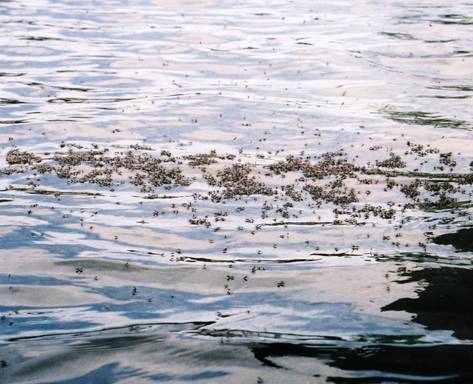
However, on days when the air is cooler the adults will emerge and ride on the surface for a considerable distance before flying off. Other times, during mating, the midge adults will cluster or ball up while on the surface. During these conditions the older and wiser trout (like me) will feed on the adults and, much to our chagrin, we can often be fooled by the angler!! But that's O.K., because it wouldn't be much fun for you if we weren't, would it?!
Before I turn the Yellowstone Fly Tyer loose on the patterns and before we discuss presentation methods we should first have a better understanding of why we trout even feed on such small morsels. Now remember the trout's survival is based on energy spent versus energy taken in. Therefore we often eat what is most abundant and easiest to capture. I especially like the easiest to capture types. At various times of the year the numbers of midges that are hatching are unbelievable. During these time periods I can really put on the weight and at times midges are the only food form that is available in reasonable numbers. Now on to the patterns.
I hope you were able pick up on the important information offered by "Bugzy", for a brown trout he sure is a wise guy in more ways than one!!! For those of you who might be wondering how "Bugzy" writes his part of the column, well he works on a special underwater computer developed by the Fish Technology Center. He uses micro-fish disks and the fish-perfect III writing program that is IBM compatible. Once I receive the material and de-slime it, we're ready to go. But enough chit chat.
To be completely prepared, the angler/tyer should have imitations of adults, captive or crippled adults, semi-emerged adults, stillborn midges, midge pupa that can be fished anywhere from the bottom to the surface film, emerging midge pupa and midge worms. Does this mean that the angler/tyer needs to have eight to ten different pattern types? No, the trick is choosing patterns that maybe used in several different situations. I also believe that one of the most important tools that the angler/tyer can carry while fishing is a good, sharp pair of scissors that will allow you to do some trimming so that these patterns can be made to fit any angling situation you may encounter. Now, this pattern selection should be tied in the proper sizes and in the proper colors for the waters you fish. Being an organized person, I will start at the bottom with the midge larvae and work my way up.
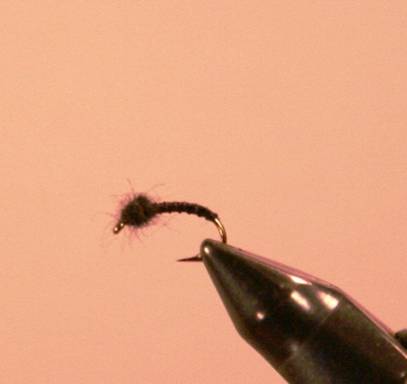
Olive New Dubb Midge Worm
- Hook: Tiemco 2487 Sizes: 14-20
- Thread: 8/0 Olive
- Underbody: Olive thread
- Body: Dark olive New Dubb
This pattern is also effective when tied in light olive and red. I tie this pattern with no weight added to the hook, therefore when I observe midge worms floating in or just under the surface film; I simply grease the leader and place the imitation in the proper zone without having to construct a new pattern. If I need to put the imitation deeper in the water column I will simply add weight to the leader.
Emerging Para Midge Pupa, Black
- Hook: Tiemco 100 Sizes: 14-26
- Thread: Black 8/0
- Shuck: (Optional) Tuft of Scintilla #01 Coal Black
- Abdomen: Moose mane or peacock hurl stripped and dyed to the proper color
- Wingpost: White Antron Body Wool fibers
- Head: Dubbed, sheared muskrat fur, dyed black
- Hackle: Black, undersized, tied parachute style
Tying Notes: On larger sizes of (14 to 18) you may wish to build up a tapered underbody of black tying thread. You also may use stripped or bleached and dyed peacock hurl in place of the moose mane. A tip for making a super durable imitation using these materials is to place a thin coat of Super Glue Gel on the hook shank prior to wrapping the moose mane or peacock hurl. Remember to soak the moose mane or peacock hurl in water prior to wrapping.
This pattern is ideal for the emerging midge pupa. However if you need to fish a midge pupa deeper in the water column, simply take your handy scissors and trim off the shuck, wingpost and hackle and you are left with a very durable and functional midge pupa.
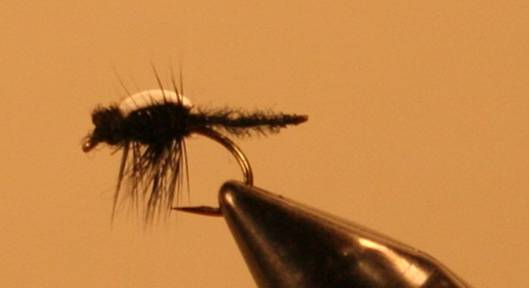
Gray Captive Midge
- Hook: Tiemco 2487 Sizes: 14-24
- Thread: Black 8/0
- Abdomen Extension: Lt. Gray New Dubb, burn the tip
- Wingcase: White dry cell foam, tied in and pulled over the top of the thorax after the thorax is dubbed and hackle palmered
- Hackle: Undersized, grizzly, palmered through the thorax
- Thorax: Dubbed, sheared natural gray muskrat fur
- Head: Dubbed, sheared muskrat fur, dyed black
Tying Notes: The body extension is tied down at the mid-point of the hook shank and should be equal to the length of the hook shank. This pattern can also be used as a floating midge emerger, simply trim off the hackle.
The last pattern I will discuss is the Multi-Purpose Midge, This pattern is no stranger to the readership of American Angler. (See the American Angler May/June 1993, Page 30, Tom's Multi-Purpose Midge, By Mike Dry & Tom Travis) This pattern maybe tied in several different color variations to fill your needs and may be used in many different angling situations.
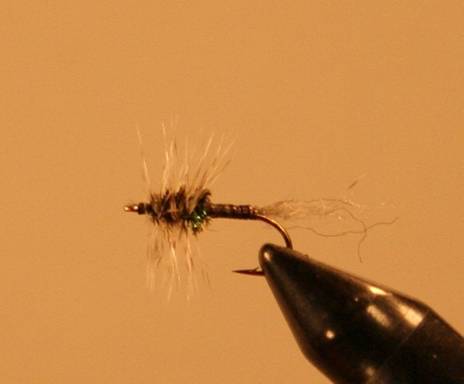
Tom's Multi-Purpose Midge
- Hook: Tiemco 101 Sizes: 14-24
- Thread: Black 8/0
- Shuck: Tuft of Scintilla dubbing
- Abdomen: Moose mane or stripped peacock hurl
- Hackle: Grizzly, palmered through the thorax, undersized
- Thorax: Peacock hurl
Tying Notes: Moose mane and stripped peacock hurl may be dyed many different useful colors. For a very durable imitation follow the same directions as given with the Emerging Para Midge.
This pattern is definitely a true multi-purpose imitation as it can be used as an emerging adult, adult, spent adult and stillborn adult all with a little trimming with the scissors. I also construct these imitation using turkey biots and/or porcupine quills that was dyed various colors.
Now, I would like to take some time to discuss presentation methods that I have found effective. However "Bugzy" says that's his area and I'll be darned if Joe Migliore and Art Scheck didn't back up the crafty old brown trout!!
There are many different presentation methods that I could discuss, however the one that I see many anglers having problems with is flat water midging situations. During the major midge hatches, locating us trout is often very simple as you anglers will readily see us feeding. But now that you have found us the hard part begins. Let me tell you right off the key to successful midging on flat, clear water is CAREFUL OBSERVATION!!!!
Move, slowly and carefully and get as close as possible to the feeding trout, remembering that you must not let us see you and that you must move slowly and quiet enough so your movements don't spook us. Once you have gained a suitable observation station then you can determine what form of midge we are feeding on. If there are several of us trout working the area, you must treat each of us as an individual. There is no rule that says that all trout MUST be eating the same stage of the midge at the same time. Think about it, do all anglers eat the same thing!
To better explain I will relate how I observed an angler that was able to solve a tough and challenging midging situation through careful observation, thoughtful pattern selection and proper presentation method.
One year during March, I was enjoying the feast provided by a heavy midge emergence on one of my favorite western spring creeks. I noticed that the anglers were having a rather difficult time of it, even though all my friends were feeding very actively. Then I noticed an angler who was stationed at the tail of a long flat and was within easy casting distance (15 to 30 feet) of nine or ten actively feeding trout.
This angler didn't start casting about in a willy-nilly manner. Rather he sat there very quietly and observed how my friends were feeding. Then he slipped quietly into the water below the feeding trout and dipped an insect net into the water. I immediately knew that this guy was going to be trouble with a capital T.
What the angler observed was that not all of the trout were feeding on the same stage of the midge at the same time. He was obviously collecting some of the insects to match the size, shape and color of the naturals to the imitations he was choosing. I saw him select an imitation and tie it on and I watched as he trimmed several of the patterns and added them to the selection on his foam fly patch.
As it turned out trout #1 was feeding on midge pupas that were floating 3 to 6 inches below the surface film. Trout #2 was feeding on semi-emerged midges trapped in the surface film. Trout #3 was holding close to a bank where the current was pushing stillborn midges. Trout #4 was a smaller silly rainbow who was feeding on adults. Trout #5 was feeding on midge pupas that were floating in the surface film. Trout #6 was feeding on midge worms. All six of these trout were hooked and netted by the angler. They all had their stomachs pumped and were then gently released by the angler. Oh, what about the other three trout? Well as it turns out the angler who was so careful and observant was fishing with the Yellowstone Fly Tyer, whom he called to come share in the good fishing. Well the "Fly Tyer" did manage to hook Trout #7 on a midge pupa, and then promptly lost him on the strike. Just lift and tighten, don't try to rip our lips off! Trout #8 was spooked by a bad cast. Trout #9 was spooked by a clumsy approach. The "Fly Tyer" tripped over a stick and darn near fell in. All of the dancing around to regain his balance was just a little more movement than any of us were going to tolerate so we just stopped feeding.
I heard the other angler explain to the "Fly Tyer" that careful approach and observation were the keys to his success. I would also add the he treated each trout as an individual and was not afraid to change flies. The angler's casts were accurate and precise and he had a good understanding of the drifts and current line. The "Fly Tyer" on the other hand, well he does amaze me, for someone who ties such a nice fly, he sure is clumsy and therefore not a lot of danger to the fishery!
Remember fishing is fun, but catch and release is a life or death matter to me and my friends!
"Bugzy Brown Trout"
I hope you enjoyed this selection and remember that trout fishing should be fun, but that doesn't mean that it isn't also serious.
Enjoy & Good Fishin'
| Sysadmin Note |
|---|
| Part seventeen can be found here |
